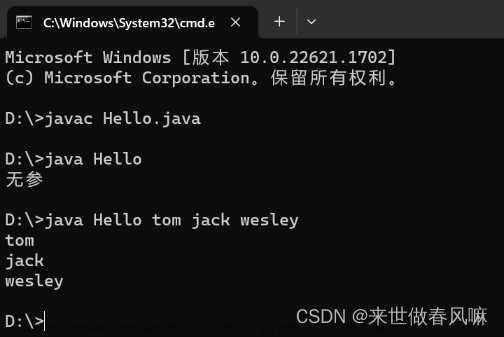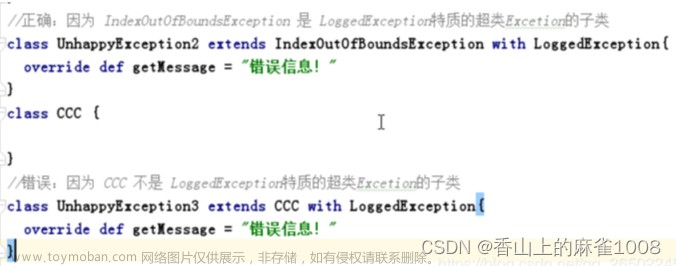
【Java核心技术】Java基本语法
【Java核心技术】Java面向对象编程
【Java核心技术】Java异常处理
【Java高级编程】Java多线程
【Java高级编程】Java常用类
【Java高级编程】Java枚举类&注解
【Java高级编程】Java集合
【Java高级编程】Java泛型
【Java高级编程】JavaIO流
【Java高级编程】Java网络编程
【Java高级编程】Java反射机制
【Java高级编程】Java8的新特性
1、File类的使用
1.1、File类的理解
- File类的一个对象,代表一个文件或一个文件目录(俗称:文件夹)
- File类声明在java.io包下
- File类中涉及到关于文件或文件目录的创建、删除、重命名、修改时间、文件大小等方法,并未涉及到写入或读取文件内容的操作。如果需要读取或写入文件内容,必须使用IO流来完成。
- 后续File类的对象常会作为参数传递到流的构造器中,指明读取或写入的“终点”
1.2、File的实例化
- 常见构造器
- File(String filePath)
- File(String parentPath, String childPath)
- File(File parentFile, String childPath)
- 路径的分类
- 相对路径:相较于某个路径下,指明的路径
- 绝对路径:包含盘符在内的文件或文件目录的路径
- 路径分隔符
- public static final String separator:根据操作系统,动态的提供分隔符
1.3、常用方法
- File类的获取功能
- public String getAbsolutePath():获取绝对路径
- public String getPath():获取路径
- public String getName():获取名称
- public String getParent():获取上层文件目录。若无,返回null
- public long length():获取文件长度(即:字节数)。不能获取目录的长度。
- public long lastModified():获取最后一次的修改时间,毫秒值
- public String[] list():获取指定目录下的所有文件或文件目录的名称数组
- public File[] listFiles():获取指定目录下的所有文件或文件目录的File数组
- File类的重命名功能
- public boolean renameTo(File dest):把文件重命名为指定的文件路径。要想保证返回true,需要源文件在硬盘中存在,且目标文件不能在硬盘中存在
- File类的判断功能
- public boolean isDirectory():判断是否是文件目录
- public boolean isFile():判断是否是文件
- public boolean exists():判断是否存在
- public boolean canRead():判断是否可读
- public boolean canWrite():判断是否可写
- public boolean isHidden():判断是否隐藏
- File类的创建功能
- public boolean creatNewFile():创建文件。若文件存在,则不创建,返回false
- public boolean mkdir():创建文件目录。如果文件目录存在,就不创建了。如果此文件目录的上层目录不存在,也不创建。
- public boolean mkdirs():创建文件目录。如果上层文件目录不存在,一并创建
- File类的删除功能
- public boolean delete():删除文件或文件夹。要删除一个文件目录,请注意该文件目录内不能包含文件或文件目录
2、IO原理及流的分类
2.1、流的分类
- 按操作数据单位不同分为:字节流、字符流
- 按数据流的流向不同分为:输入流、输出流
- 按流的角色的不同分为:节点流、处理流
2.2、流的体系结构
| 分类 | 字节输入流 | 字节输出流 | 字符输入流 | 字符输出流 |
|---|---|---|---|---|
| 抽象基类 | InputStream | OutputStream | Reader | Writer |
| 访问文件 | FileInputStream | FileOutputStream | FileReader | FileWriter |
| 访问数组 | ByteArrayInputStream | ByteArrayOutputStream | CharArrayReader | CharArrayWriter |
| 访问管道 | PipedInputStream | PipedOutputStream | PipedReader | PipedWriter |
| 访问字符串 | StringReader | StringWriter | ||
| 缓冲流 | BufferedInputStream | BufferedOutputStream | BufferedReader | BufferedWriter |
| 转换流 | InputStreamReader | OutputStreamWriter | ||
| 对象流 | ObjectInputStream | ObjectOutputStream | ||
| FilterInputStream | FilterOutputStream | FilterReader | FilterWriter | |
| 打印流 | PrintStream | PrintWriter | ||
| 推回输入流 | PushbackInputStream | PushbackReader | ||
| 特殊流 | DataInputStream | DataOutputStream |
2.3、输入、输出的标准化过程
- 输入过程
- 创建File类的对象,指明读取的数据的来源。(要求此文件一定要存在)
- 创建相应的输入流,将File类的对象作为参数,传入流的构造器中
- 具体的读入过程
- 关闭流资源
- 输出过程
- 创建File类的对象,指明写出的数据的位置。(不要求此文件一定要存在)
- 创建相应的输出流,将File类的对象作为参数,传入流的构造器中
- 具体的写出过程
- 关闭流资源
说明:程序中出现的异常需要使用try-catch-finally处理
3、节点流(或文件流)
3.1、FileReader的使用
- read()的理解:返回读入的一个字符。如果达到文件末尾,返回-1
- 异常的处理:为了保证流资源一定可以执行关闭操作。需要使用try-catch-finally处理
- 读入的文件一定要存在,否则就会报FileNotFoundException
@Test
public void testFileReader1 () {
FileReader fr = null;
try {
// 1、File类的实例化
File file = new File("hello.txt");
// 2、FileReader流的实例化
fr = new FileReader(file);
// 3、读入的操作
// read(char[] cbuf):返回每次读入cbuf数组中的字符的个数。如果达到文件末尾则返回-1
char[] cbuf = new char[5];
int len;
while ((len = fr.read(cbuf)) != -1) {
String str = new String(cbuf, 0, len);
System.out.println(str);
}
} catch (FileNotFoundException e) {
e.printStackTrace();
} catch (IOException e) {
e.printStackTrace();
} finally {
if (fr != null) {
// 4、关闭资源
try {
fr.close();
} catch (IOException e) {
e.printStackTrace();
}
}
}
}
3.2、FileWriter的使用
- 输出操作,对应的File可以不存在。并不会报异常
- File对应的硬盘中的文件如果不存在,在输出的过程中,会自动创建此文件。
- File对应的硬盘中的文件如果存在:
- 如果流使用的构造器是:FileWriter(file, false) / FileWriter(file):对原有文件的覆盖
- 如果流使用的构造器是:FileWriter(file, true):不会对原有文件覆盖,而是在原有文件基础上追加内容
@Test
public void testFileWriter () {
FileWriter fw = null;
try {
// 1、提供File类的对象,指明写出到的文件
File file = new File("hello1.txt");
// 2、提供FileWriter的对象,用于数据的写出
fw = new FileWriter(file, false);
// 3、写出的操作
fw.write("I have a dream!\n");
fw.write("you need to have a dream!");
} catch (IOException e) {
e.printStackTrace();
} finally {
// 4、流资源的关闭
if (fw != null) {
try {
fw.close();
} catch (IOException e) {
e.printStackTrace();
}
}
}
}
3.3、文本文件的复制
@Test
public void testFileReaderFileWriter () {
FileReader fr = null;
FileWriter fw = null;
try {
// 1、创建File类的对象,指明读入和写出的文件
File srcFile = new File("hello.txt");
File destFile = new File("hello2.txt");
// 2、创建输入流和输出流的对象
fr = new FileReader(srcFile);
fw = new FileWriter(destFile);
// 3、数据的读入和写出操作
char[] cbuf = new char[5];
int len; // 记录每次读入到cbuf数组中的字符的个数
while ((len = fr.read(cbuf)) != -1) {
// 每次写出len个字符
fw.write(cbuf, 0, len);
}
} catch (IOException e) {
e.printStackTrace();
} finally {
// 4、关闭流资源
if (fw != null) {
try {
fw.close();
} catch (IOException e) {
e.printStackTrace();
}
}
if (fr != null) {
try {
fr.close();
} catch (IOException e) {
e.printStackTrace();
}
}
}
}
3.4、FileInputStream/FileOutputStream的使用
- 对于文本文件(.txt, .java, .c, .cpp),使用字符流处理
- 对于非文本文件(.jpg, .mp3, .mp4, .avi, .doc, .ppt,…),使用字节流处理
/**
* 实现对图片的复制操作
*/
@Test
public void testFileInputOutputStream () {
FileInputStream fis = null;
FileOutputStream fos = null;
try {
// 1、造文件
File srcFile = new File("爱情与友情.jpg");
File destFile = new File("爱情与友情2.jpg");
// 2、造流
fis = new FileInputStream(srcFile);
fos = new FileOutputStream(destFile);
// 3、复制的过程
byte[] buffer = new byte[5];
int len;
while ((len = fis.read(buffer)) != -1) {
fos.write(buffer, 0, len);
}
} catch (IOException e) {
e.printStackTrace();
} finally {
// 4、关闭流
if (fis != null) {
try {
fis.close();
} catch (IOException e) {
e.printStackTrace();
}
}
if (fos != null) {
try {
fos.close();
} catch (IOException e) {
e.printStackTrace();
}
}
}
}
说明:
IDEA中:如果大家开发使用JUnit中的单元测试方法测试,相对路径即为当前Module下。如果使用main()测试,相对路径即为当前的Project下。
Eclipse中:不管使用单元测试方法还是使用main()测试,相对路径都是当前的Project下
4、缓冲流
4.1、缓冲流涉及到的类
- BufferedInputStream
- BufferedOutputSteam
- BufferedReader
- BufferedWriter
4.2、作用
- 提高流的读取、写入的速度。
- 提高读写速度的原因:内部提供了一个缓冲区。默认情况下是8kb
public class BufferedInputStream extends FilterInputStream {
private static int DEFAULT_BUFFER_SIZE = 8192;
}
4.3、典型代码
- 使用BufferedInputStream和BufferedOutputStream:处理非文本文件
@Test
public void copyFileWithBuffered(String srcPath, String destPath) {
BufferedInputStream bis = null;
BufferedOutputStream bos = null;
try {
// 1、造文件
File srcFile = new File(srcPath);
File destFile = new File(destPath);
// 2、造流
// 2.1、造节点流
FileInputStream fis = new FileInputStream(srcFile);
FileOutputStream fos = new FileOutputStream(destFile);
// 2.2、造缓冲流
bis = new BufferedInputStream(fis);
bos = new BufferedOutputStream(fos);
// 3、复制的细节:读取、写入
byte[] buffer = new byte[10];
int len;
while ((len = bis.read(buffer)) != -1) {
bos.write(buffer, 0, len);
// bos.flush(); //刷新缓冲区
}
} catch (IOException e) {
e.printStackTrace();
} finally {
// 4、资源关闭
// 要求:先关闭外层的流,再关闭内层的流
if (bis != null) {
try {
bis.close();
} catch (IOException e) {
e.printStackTrace();
}
}
if (bos != null) {
try {
bos.close();
} catch (IOException e) {
e.printStackTrace();
}
}
// 说明:关闭外层流的同时,内层流也会自动的进行关闭。关于内层流的关闭,我们可以省略
// fos.close();
// fis.close();
}
}
- 使用BufferedReader和BufferedWriter:处理文本文件
@Test
public void testBufferedReaderBufferedWriter () {
BufferedReader br = null;
BufferedWriter bw = null;
try {
// 创建文件和相应的流
br = new BufferedReader(new FileReader(new File("dbcp.txt")));
bw = new BufferedWriter(new FileWriter(new File("dbcp1.txt")));
// 读写操作
// 方式一:使用char[]数组
// char[] cbuf = new char[1024];
// int len;
// while ((len = br.read(cbuf)) != -1) {
// bw.write(cbuf, 0, len);
// }
// 方式二:使用String
String data;
while ((data = br.readLine()) != null) {
// 方法一:
// bw.write(data + "\n"); // data中不包含换行符
// 方法二:
bw.write(data);
bw.newLine(); // 提供换行的操作
}
} catch (IOException e) {
e.printStackTrace();
} finally {
// 关闭资源
if (br != null) {
try {
br.close();
} catch (IOException e) {
e.printStackTrace();
}
}
if (bw != null) {
try {
bw.close();
} catch (IOException e) {
e.printStackTrace();
}
}
}
}
5、转换流
5.1、转换流涉及到的类:属于字符流
- InputStreamReader:将一个字节的输入流转换为字符的输入流
- 解码:字节、字节数组 —> 字符数组、字符串
- OutputStreamWriter:将一个字符的输出流转换为字节的输出流
- 编码:字符数组、字符串 —> 字节、字节数组
说明:编码决定了解码的方式文章来源:https://www.toymoban.com/news/detail-510917.html
5.2、作用
- 提供字节流与字符流之间的转换
5.3、典型实现
- 文件编码的方式(比如:GBK),决定了解析时使用的字符集(也只能是GBK)
@Test
public void test2 () {
InputStreamReader isr = null;
OutputStreamWriter osw = null;
try {
// 1、造文件、造流
File file1 = new File("dbcp.txt");
File file2 = new File("dbcp_gbk.txt");
FileInputStream fis = new FileInputStream(file1);
FileOutputStream fos = new FileOutputStream(file2);
// isr = new InputStreamReader(fis); // 使用系统默认的字符集
isr = new InputStreamReader(fis, "utf-8");
osw = new OutputStreamWriter(fos, "gbk");
// 2、读写过程
char[] cbuf = new char[20];
int len;
while ((len = isr.read(cbuf)) != -1) {
osw.write(cbuf, 0, len);
}
} catch (IOException e) {
e.printStackTrace();
} finally {
// 3、关闭资源
if (isr != null) {
try {
isr.close();
} catch (IOException e) {
e.printStackTrace();
}
}
if (osw != null) {
try {
osw.close();
} catch (IOException e) {
e.printStackTrace();
}
}
}
}
5.4、常见的编码表
- ASCII:美国标准信息交换码。用一个字节的7位可以表示。
- ISO8859-1:拉丁码、欧洲码表。用一个字节的8位表示
- GB2312:中国的中文编码表。最多两个字节编码所有字符
- GBK:中国的中文编码表升级,融合了更多的中文文字符号。最多两个字节编码
- Unicode:国际标准码,融合了目前人类使用的所有字符。为每个字符分配唯一的字符码。所有的文字都用两个字节来表示。
- UTF-8:变长的编码方法,可用1-4个字节来表示一个字符。
6、其它的流的使用
6.1、标准输入、输出流
- System.in:标准的输入流,默认从键盘输入
- System.out:标准的输出流,默认从控制台输出
- 修改默认的输入和输出行为
- System类的setIn(InputStream is)/setOut(PrintStream ps)方式重新指定输入和输出的流
6.2、打印流
- PrintStream和PrintWriter
- 提供了一些列重载的print()和println()方法,用于多种数据类型的输出
- System.out返回的是PrintStream的实例
6.3、数据流
- DataInputStream和DataOutputStream
- 用于读取或写出基本数据类型的变量或字符串
@Test
public void test3() {
DataOutputStream dos = null;
try {
dos = new DataOutputStream(new FileOutputStream("data.txt"));
dos.writeUTF("刘建辰");
dos.flush(); // 刷新操作,将内存中的数据写入文件
dos.writeInt(23);
dos.flush();
dos.writeBoolean(true);
dos.flush();
} catch (FileNotFoundException e) {
e.printStackTrace();
} catch (IOException e) {
e.printStackTrace();
} finally {
if (dos != null) {
try {
dos.close();
} catch (IOException e) {
e.printStackTrace();
}
}
}
}
/**
* 注意点:读取不同类型的数据的顺序要与当初写入文件时,保存的数据的顺序一致
*/
@Test
public void test4() {
DataInputStream dis = null;
try {
dis = new DataInputStream(new FileInputStream("data.txt"));
String name = dis.readUTF();
int age = dis.readInt();
boolean isMale = dis.readBoolean();
System.out.println(name);
System.out.println(age);
System.out.println(isMale);
} catch (IOException e) {
e.printStackTrace();
} finally {
if (dis != null) {
try {
dis.close();
} catch (IOException e) {
e.printStackTrace();
}
}
}
}
7、对象流
7.1、对象流
- ObjectInputStream:内存中的对象 —> 存储中的文件、通过网络传输出去(序列化过程)
- ObjectOutputSteam:存储中的文件、通过网络接受过来 —> 内存中的对象(反序列化过程)
7.2、对象的序列化机制
- 对象序列化机制允许把内存中的Java对象转换成平台无关的二进制流,从而允许把这种二进制流持久地保存在磁盘上,或通过网络将这种二进制流传输到另一个网络节点。
- 当其它程序获取了这种二进制流,就可以恢复成原来的Java对象
7.3、序列化代码实现
@Test
public void testObjectOutputSteam () {
ObjectOutputStream oos = null;
try {
// 1、造流
oos = new ObjectOutputStream(new FileOutputStream("object.dat"));
// 2、读写过程
oos.writeObject(new String("我爱北京天安门"));
oos.flush();
} catch (IOException e) {
e.printStackTrace();
} finally {
// 3、关闭资源
if (oos != null) {
try {
oos.close();
} catch (IOException e) {
e.printStackTrace();
}
}
}
}
7.4、反序列化代码实现
@Test
public void testObjectInputSteam () {
ObjectInputStream ois = null;
try {
ois = new ObjectInputStream(new FileInputStream("object.dat"));
Object obj = ois.readObject();
String str = (String) obj;
System.out.println(str);
} catch (IOException e) {
e.printStackTrace();
} catch (ClassNotFoundException e) {
e.printStackTrace();
} finally {
if (ois != null) {
try {
ois.close();
} catch (IOException e) {
e.printStackTrace();
}
}
}
}
7.5、实现序列化的对象所属的类需要满足的条件
- 需要实现接口:Serializable
- 当前类提供一个全局常量:serialVersionUID
- 除了当前类需要实现Serializable接口之外,还必须保证其内部所有属性也必须是可序列化的。(默认情况下,基本数据类型可序列化)
补充:ObjectOutputSteam和ObjectInputStream不能序列化static和transient修饰的成员变量文章来源地址https://www.toymoban.com/news/detail-510917.html
8、随机存取文件流
8.1、随机存取文件流
- RandomAccessFile
8.2、使用说明
- RandomAccessFile直接继承于java.lang.Object类,实现了DataInput和DataOutput接口
- RandomAccessFile既可以作为一个输入流,又可以作为一个输出流
- 如果RandomAccessFile作为输出流时,写出到的文件如果不存在,则在执行过程中自动创建。如果写出到的文件存在,则会对原文件内容进行覆盖。(默认情况下,从头覆盖)
- 可以通过相关的操作,实现RandomAccessFile“插入”数据的效果。seek(int pos)
8.3、典型代码
/**
* 实现复制功能
*/
@Test
public void test1 () {
RandomAccessFile raf1 = null;
RandomAccessFile raf2 = null;
try {
// 1、造流
raf1 = new RandomAccessFile(new File("爱情与友情.jpg"), "r");
raf2 = new RandomAccessFile(new File("爱情与友情1.jpg"), "rw");
// 2、读写过程
byte[] buffer = new byte[1024];
int len;
while ((len = raf1.read(buffer)) != -1) {
raf2.write(buffer, 0, len);
}
} catch (IOException e) {
e.printStackTrace();
} finally {
// 3、关闭资源
if (raf1 != null) {
try {
raf1.close();
} catch (IOException e) {
e.printStackTrace();
}
}
if (raf2 != null) {
try {
raf2.close();
} catch (IOException e) {
e.printStackTrace();
}
}
}
}
/**
* 使用RandomAccessFile实现数据的插入效果
*/
@Test
public void test3 () {
RandomAccessFile raf1 = null;
try {
raf1 = new RandomAccessFile("hello.txt", "rw");
raf1.seek(3); // 将指针调到角标为3的位置
// 保存指针3后面的所有数据到StringBuilder中
StringBuilder buildr = new StringBuilder((int) new File("hello.txt").length());
byte[] buffer = new byte[20];
int len;
while ((len = raf1.read(buffer)) != -1) {
buildr.append(new String(buffer, 0, len));
}
// 调回指针,写入“xyz”
raf1.seek(3);
raf1.write("xyz".getBytes());
// 将StringBuilder中的数据写入到文件中
raf1.write(buildr.toString().getBytes());
} catch (IOException e) {
e.printStackTrace();
} finally {
if (raf1 != null) {
try {
raf1.close();
} catch (IOException e) {
e.printStackTrace();
}
}
}
}
9、NIO.2中Path、Paths、Files类的使用
9.1、NIO的使用说明
- Java NIO(New IO, Non-Blocking IO)是从Java 1.4版本开始引入的一套新的IO API,可以替代标准的Java IO API。
- NIO与原来的IO同样的作用和目的,但是使用的方式完全不同,NIO支持面向缓冲区的(IO是面向流的)、基于通道的IO操作
- NIO将以更高效的方式进行文件的读写操作
- 随着JDK 7的发布,Java对NIO进行了极大的扩展,增强了对文件处理和文件系统特性的支持,以至于我们称他们为NIO.2
9.2、Path的使用
- Path替换原有的File类
- Paths类提供了静态get()方法用来获取Path对象:
- static Path get(String first, String … more):用于将多个字符串串连成路径
- static Path get(URI uri):返回指定uri对应的Parh路径
- 常用方法:
- String toString():返回调用Path对象的字符串表示形式
- boolean startsWith(String path):判断是否以path路径开始
- boolean endsWith(String path):判断是否以path路径结束
- boolean isAbsolute():判断是否是绝对路径
- Path getParent():返回path对象包含整个路径,不包含Path对象指定的文件路径
- Path getRoot():返回调用Path对象的根路径
- Path getFileName():返回与调用Path对象关联的文件名
- int getNameCount():返回Path根目录后面元素的数量
- Path getName(int idx):返回指定索引位置idx的路径名称
- Path toAbsolutePath():作为绝对路径返回调用Path对象
- Path resolve(Path p):合并两个路径,返回合并后的路径对应的Path对象
- File toFile():将Path转换为File类的对象
9.3、Files工具类
- 作用:操作文件或文件目录的工具类
- 常用方法:
- Path copy(Path src, Path dest, CopyOption … how):文件的复制
- Path createDirectory(Path path, FileAttribute<?> … attr):创建一个目录
- Path createFile(Path path, FileAttribute<?> … arr):创建一个文件
- void delete(Path path):删除一个文件/目录,如果不存在,执行报错
- void deleteIfExists(Path path):Path对应的文件/目录如果存在,执行删除
- Path move(Path src, Path dest, CopyOption … how):将src移动到dest位置
- long size(Path path):返回指定文件的大小
- 用于判断:
- boolean exists(Path path, LinkOption … opts):判断文件是否存在
- boolean isDirectory(Path path, LinkOption … opts):判断是否是目录
- boolean isRegularFile(Path path, LinkOption … opts):判断是否是文件
- boolean isHidden(Path path):判断是否是隐藏文件
- boolean isReadable(Path path):判断文件是否可读
- boolean isWritable(Path path):判断文件是否可写
- boolean notExists(Path path, LinkOption … opts):判断文件是否不存在
- 用于操作内存
- SeekableByteChannel newByteChannel(Path path, OpenOption … how):获取与指定文件的连接,how指定打开方式
-
DirectoryStream<Path> newDirectoryStream(Path path):打开path指定的目录 - InputStream newInputStream(Path path, OpenOption … how):获取InputStream对象
- OutputStream newOutputStream(Path path, OpenOption … how):获取OutputStream对象
到了这里,关于【Java高级编程】IO流的文章就介绍完了。如果您还想了解更多内容,请在右上角搜索TOY模板网以前的文章或继续浏览下面的相关文章,希望大家以后多多支持TOY模板网!











